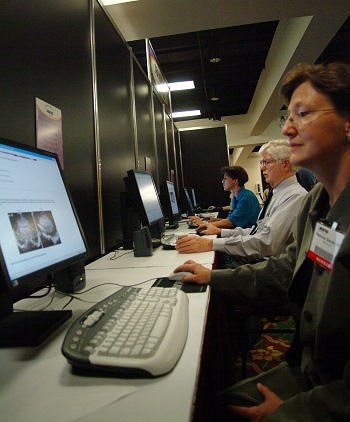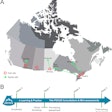
For many who have achieved board certification in diagnostic radiology since 2002, a subsequent letter from the American Board of Radiology has prompted the following questions: What are these self-assessment modules (SAMs) I now have to complete, and where do I get them?
An answer to these questions has finally arrived from the American Roentgen Ray Society (ARRS), the first organization to create ABR-approved SAMs both for a conference/online format and a journal publication.
The June issue of the ARRS' journal, the American Journal of Roentgenology, is accompanied by a new quarterly supplement designed specifically as a SAM-delivery vehicle.
Each issue of AJR Integrative Imaging will include at least one SAM, according to Associate Editor Dr. Felix Chew, who also penned the first issue's SAM on radiology of the hands.
But if you wanted to complete one of the first ABR-approved SAMs at the recent ARRS meeting, you probably had to wait in line. And the queue for computers included people who don't even need SAMs for recertification, as discovered by an AuntMinnie.com poll of participants.
 |
| Attendees at the 2005 American Roentgen Ray Society (ARRS) meeting in New Orleans tried out the first self-assessment modules approved for diagnostic radiology recertification by the American Board of Radiology. Image courtesy of ARRS. |
Anyone who gave up on completing a SAM at the meeting will be able to finish the online component on the ARRS Web site when it is uploaded in a few weeks, according to the society. The full SAMs will also be available for non-ARRS members for a fee.
During the ARRS meeting, 113 people finished the online SAM component on neonatal cranial ultrasound, and 71 completed one on imaging of the brachial plexus.
Completion of the online component was good for 0.75 credits of category 1 CME, but it wouldn't earn you a SAM credit. To get the one SAM credit you also needed to attend a lecture on the same topic, which also earned you another 1.5 credits worth of CME.
The leader of the ARRS committee behind the meeting's SAMs was surprised to find a line of people waiting to take the online component.
"It turned out to be a lot more popular than I thought it would be," said Dr. Jannette Collins, a professor of radiology and medicine at the University of Wisconsin in Madison.
Dr. Humberto Wong, a Stanford University resident, confirmed Collins' theory that curiosity might have spurred participation among those who will have to complete SAMs in the future. He deemed the ARRS offerings "interesting presentations."
In addition, radiologists with lifetime certification might be required to complete SAMs under the rules of their hospitals or states, Collins noted. But that wasn't a motivating factor for Dr. Peerapod Chiowanich, a 1997 ABR diplomate now at Roosevelt Hospital in New York City.
Chiowanich said he found the online SAMs to be helpful, but was ambivalent as to whether they should be required for maintenance of certification. "It's a nice way of committing someone to lifelong learning, I guess," he said.
While other radiology organizations are also now developing SAMs for diagnostic radiology, the ARRS is the first to interpret the loose guidelines provided by the ABR.
According to Collins, the primary requirements are that SAMs include some type of educational content -- a lecture or published article, for example -- and that it have multiple-choice questions with detailed explanations for each correct and incorrect answer.
References must be provided and participants must be given feedback on their score and their performance relative to others who have completed the same SAM, Collins added.
But the ABR hasn't specified that a SAM must have a minimum number of questions. Nor is a participant required to achieve a certain score on the SAM, as that would be contrary to the spirit of the exercise, Collins suggested.
"It's not a test to measure how much you know. It's an instrument that allows you to determine what your gaps in knowledge are, and should help you develop your own educational plan," Collins said.
That said, the ABR could impose more requirements as they approve more SAMs in the future, Collins noted. "I think they've been pretty lenient because they really want to get started and get this going."
Based on Collins' conversations with recent diplomates, that's a good thing. The gap between the start of time-limited board certification and the availability of the mandatory SAMs has been a little frustrating for those who are subject to the new regime.
"Those who were certified in 2002 have had almost three years now into their 10-year recertification period. They only have seven years left in which to complete their 20 SAMs," Collins observed. "So they feel like there are these requirements put upon them, but there's not been a lot of resources to help them meet those requirements."
By Tracie L. Thompson
AuntMinnie.com staff writer
June 1, 2005
Related Reading
ABR's recertification program spurs confusion, complaints, October 19, 2004
ABR issues nuclear radiology update, October 14, 2004
Preparing for the ABR oral exam: a resident's guide, February 19, 2004
ABR and RRC activities: radiology's regulators talk, May 17, 2002
Copyright © 2005 AuntMinnie.com



















